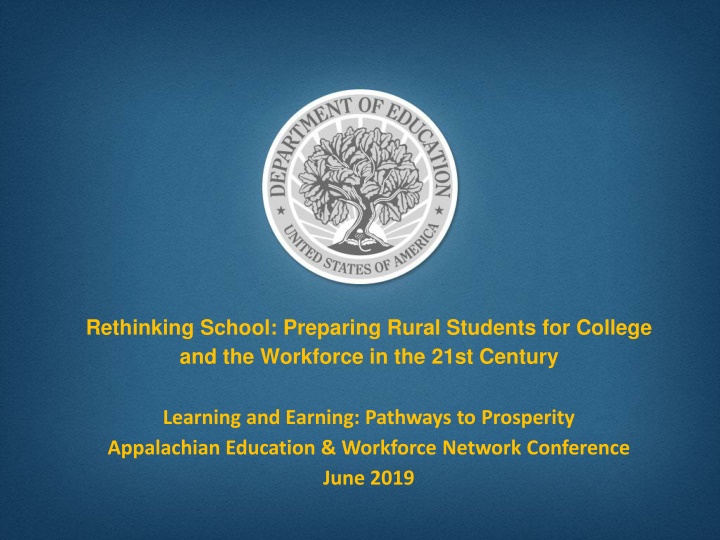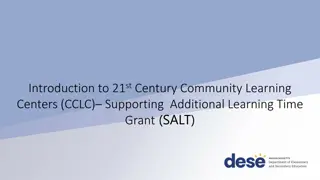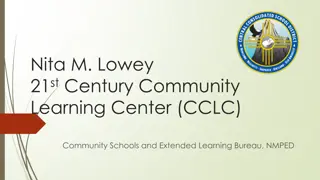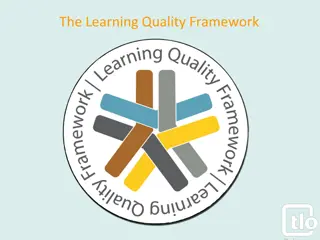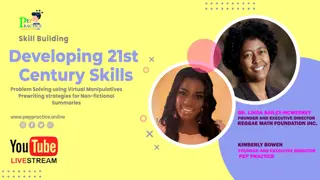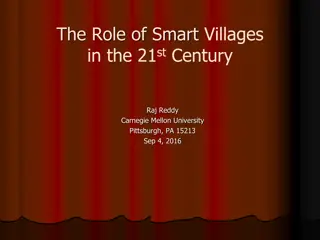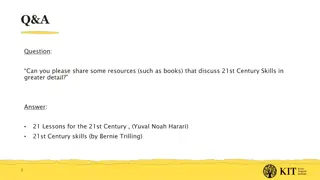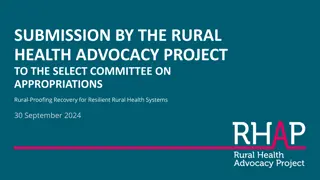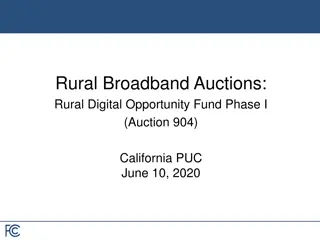Empowering Rural Students for Success in the 21st Century: Challenges and Opportunities
Exploring the educational landscape for rural students, this presentation delves into rethinking traditional schooling methods to better prepare students for future careers. Addressing questions posed by Secretary DeVos, the content emphasizes the need to overcome challenges and barriers faced by rural students in their quest for prosperity. With insights on rural definitions, educational attainment data, and the diverse nature of rural schools, the discussion aims to inspire innovative approaches for enhancing rural education and workforce readiness.
Download Presentation

Please find below an Image/Link to download the presentation.
The content on the website is provided AS IS for your information and personal use only. It may not be sold, licensed, or shared on other websites without obtaining consent from the author.If you encounter any issues during the download, it is possible that the publisher has removed the file from their server.
You are allowed to download the files provided on this website for personal or commercial use, subject to the condition that they are used lawfully. All files are the property of their respective owners.
The content on the website is provided AS IS for your information and personal use only. It may not be sold, licensed, or shared on other websites without obtaining consent from the author.
E N D
Presentation Transcript
Rethinking School: Preparing Rural Students for College and the Workforce in the 21st Century Learning and Earning: Pathways to Prosperity Appalachian Education & Workforce Network Conference June 2019
RETHINK SCHOOL What do you think when you hear the phrase Rethink School ? What were your thoughts about what to expect when you read the title of this breakout?
RETHINK SCHOOL Secretary DeVos: Question everything to ensure nothing limits students from being prepared for what comes next. Ask fundamental questions Why limit educators? Why assign kids to schools based on their address? Why group kids by age? Why force all students to learn at the same speed? Why measure learning by hours and days? Why suggest a college degree is the only path to success? Why believe education stops at graduation? Rural families, rural teachers and rural leaders must answer these questions and more What do you see as the major challenges or obstacles rural students face in finding or following their pathways to prosperity?
WHAT IS RURAL? Different things to different people What s left Federal definitions USDA Economic Research Service Census Bureau Others
WHAT IS RURAL? If you ve seen one rural school Rural is not a monolith but a compilation of thousands of unique communities and circumstances. ED s Rural Report Differences between states and among states
PERCENTAGE 25 YEARS AND OLDER WHO COMPLETED HIGH SCHOOL https://nces.ed.gov/surveys/ruraled/tables/b.3.c.-1.asp 8
RURAL MATTERS Trends in Rural America Traditional rural industries waning (ag, mining, manufacturing) Population, employment, poverty trends Brain drain Graying of rural areas Opioid crisis Rural residents wondered if their voices were being heard What do you believe are the biggest challenges facing rural students?
EDUCATION FREEDOM SCHOLARSHIPS (EFS) All students need to be freed to pursue the education that will unlock their potential and unleash their creativity so they and our country can achieve unlimited success. Education Secretary Betsy DeVos Among the obstacles rural students can face Access to advanced and specialized coursework Distance to training centers/community colleges Secretary s EFS proposal can help students overcome these obstacles
EDUCATION FREEDOM SCHOLARSHIPS (EFS) States identify Scholarship Granting Organizations (SGOs) Individuals and businesses receive Federal tax credit for donating SGOs award scholarships to students States determine structure and allowable expenses Participation is voluntary Not about choosing different school buildings
EDUCATION FREEDOM SCHOLARSHIPS (EFS) Designed to work hand-in-hand with students existing public education options Could cover expenses for: AP and IB courses Elective courses Credit recovery and remedial courses Tutoring services Education technology purchases Fees for summer and specialized after-school programs Others
EDUCATION FREEDOM SCHOLARSHIPS (EFS) Designed to work hand-in-hand with students existing public education options Close the skills gap Align vision and strategies with Perkins V and WIOA Could cover certain expenses for career training options: Dual enrollment Apprenticeships Industry certifications Transportation Tools, supplies and PPE costs Others
RURAL REPORT RECOMMENDATIONS 1. Create intra-agency rural working group 2. Expand rural listening sessions 3. Explore simplifying applications, documents, and processes 4. Develop training for rural schools and districts 5. Explore increased collaboration with other Federal agencies and commissions 6. Develop a comprehensive communications plan 7. Enhance rural education data
SUPPLEMENTAL PRIORITIES Priority 1 Empowering Families and Individuals to Choose a High-Quality Education that Meets Their Unique Needs. Priority 2 Promoting Innovation and Efficiency, Streamlining Education with an Increased Focus on Improving Student Outcomes, and Providing Increased Value to Students and Taxpayers. Priority 3 Fostering Flexible and Affordable Paths to Obtaining Knowledge and Skills. Priority 4 Fostering Knowledge and Promoting the Development of Skills that Prepare Students to be Informed, Thoughtful, and Productive Individuals and Citizens. Priority 5 Meeting the Unique Needs of Students and Children with Disabilities and/or those with Unique Gifts and Talents. Priority 6 Promoting Science, Technology, Engineering, or Math (STEM) Education, with a Particular Focus on Computer Science. Priority 7 Promoting Literacy. Priority 8 Promoting Effective Instruction in Classrooms and Schools. Priority 9 Promoting Economic Opportunity. Priority 10 Protecting Freedom of Speech and Encouraging Respectful Interactions in a Safe Educational Environment. Priority 11 Ensuring that Service Members, Veterans, and Their Families Have Access to High-Quality Educational.
RURAL PRIORITY AREAS Priority 1(b)(i): Increasing access to educational choice for [c]hildren or students in communities served by rural local educational agencies. Priority 6(d): Expanding access to and participation in rigorous computer science coursework for traditionally underrepresented students such as racial or ethnic minorities, women, students in communities served by rural local educational agencies. Priority 6(h): Utilizing technology for educational purposes in communities served by rural local educational agencies or other areas identified as lacking sufficient access to such tools and resources. Priority 8(c)(ii): Promoting innovative strategies to increase the number of students who have access to effective educators in [s]chools that are located in communities served by rural local educational agencies. Priority 8(d)(ii): Promoting innovative strategies to increase the number of students who have access to effective principals or other school leaders in [s]chools that are located in communities served by rural local educational agencies.
STEM STRATEGIC PLAN Vision Strengthens Federal commitment to Equity and diversity Evidence-based practice Engagement with national STEM community North Star Ensure all Americans have access to quality STEM education
STEM STRATEGIC PLAN What innovative means are you using to expand students access to STEM education?
AMERICAN BROADBAND INITIATIVE Lack of access is a barrier for many rural students Expanding connectivity is essential to expanding education freedom and opportunities for rural students Recommendations to Streamline Federal permitting Leverage Federal assets Maximize the impact of Federal funding ED commitments Create an interagency working group and develop and test strategies to increase broadband access for students in and outside of school Measure equity in technology access in upcoming Civil Rights Data Collection survey Work with DOI's BIA, IMLS and Native American communities to develop and convene a Tribal Broadband Summit.
AMERICAN BROADBAND INITIATIVE Status of school connectivity OET listening sessions Connectivity is not the end goal Increasing access to additional course choices Incorporating more advanced technology into the classroom, improving the learning environment Creating more options and more opportunities for students What is the status of connectivity in your school and your area?
RETHINK CTE Nimble, demand-driven talent development system Multiple pathways Perkins V Provides funding for CTE Workforce needs in manufacturing Good news for employers, communities and others worried about the skills gap Promotes better alignment with economic needs Helps students and families make better-informed decisions Gives states, school districts and community colleges greater freedom Discretionary grants Pathways to STEM Apprenticeship Innovation and Modernization
RETHINK SCHOOL (RURAL INNOVATION) ESSA shifts much of the power and control of education from the Federal government to state and local governments and education agencies. Revisit fundamental questions Why limit educators? Why assign kids to schools based on their address? Why group kids by age? Why force all students to learn at the same speed? Why measure learning by hours and days? Why suggest a college degree is the only path to success? Why believe education stops at graduation? Rural schools may be the best places to rethink these questions, and more
LINKS Rural Report: https://www2.ed.gov/about/inits/ed/rural/rural-education- report.pdf EFS information: https://sites.ed.gov/freedom/ White House STEM Strategic Plan: https://www.whitehouse.gov/wp- content/uploads/2018/12/STEM-Education-Strategic-Plan- 2018.pdf American Broadband Initiative Report: https://www.ntia.doc.gov/files/ntia/publications/american_ broadband_initiative_milestones_report.pdf Broadband USA Funding: https://broadbandusa.ntia.doc.gov/funding-list
Michael Chamberlain Office of Rural and Community Engagement Michael.Chamberlain@ed.gov
